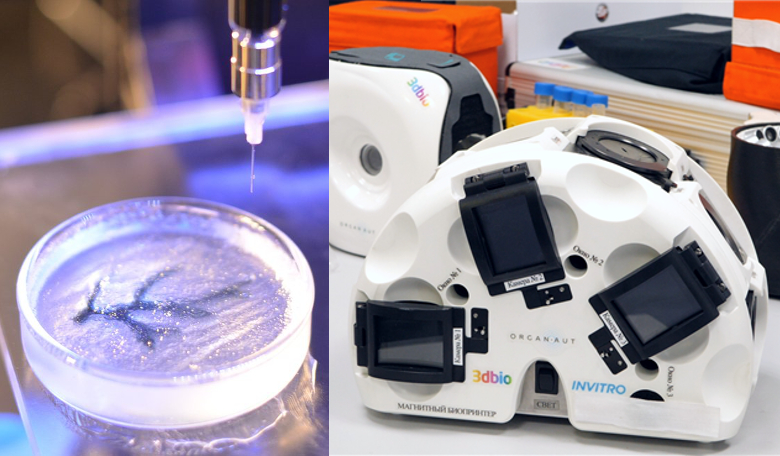It is now becoming increasingly commonplace to build rockets from parts made from additive manufacturing, but could a different type of 3D printing involving the human body soon be the new normal for keeping astronauts alive on long duration flights beyond low Earth orbit?
Heading to the International Space Station (ISS) in December, is an experiment that gives body-building a whole new meaning. Due for delivery onboard a Soyuz MS-11 manned transportation spacecraft set for launch from the Baikonur Cosmodrome, is a copy of an Organ-Avt bioprinter – a device used to grow living tissue.
The printer, a version of which could one day 3D print organs, is part of an experiment devised by a Russian start-up bio-technical research laboratory known as 3D Bioprinting Solutions and it will be the world's first experiment on printing organ tissue in space.
The experiment was bound for the ISS last month, but the aborted launch of the Soyuz-FG booster that was carrying it, resulted in the printer coming to an abrupt end as it was jettisoned from the habitation module before the spacecraft plummeted back to Earth. The original program was comprised of 56 experiments, including the growth of small 2-3 millimetre samples of human cartilage tissue and the thyroid gland of a rodent from a hydrogel-based material.
Building spare body parts from additive manufacturing while far from the homely comforts of Earth is a natural step forward if humans want to be successful at establishing permanent bases elsewhere in the Solar System (and possibly beyond).
It is already envisaged that the technology is practically indispensable for building spacecrafts and settlements from in-situ resources out in the expanses of space, when popping back to Earth for some key components is no longer an option. Indeed, a number of companies on this planet are already practising with other-worldly materials to see how it can be done.
Contemplating how to keep astronauts alive far from home, has also been the focus of a two-day workshop held at ESA’s ESTEC centre in Noordwijk this week. Here, a leading group of 3D bioprinting experts from around the world gathered to discuss the latest in growing essential bits of the body in outer space.
“For the first time in Europe, all the relevant experts have come together to discuss applying 3D bioprinting and regenerative medicine for space,” said Tommaso Ghidini, head of ESA’s Structures, Mechanisms and Materials Division, overseeing the project.
“We’re asking what astronauts would need in the short, medium and long term, and what steps are needed to mature 3D bioprinting to a level where it can be useful in space. We’re defining a development roadmap and timeline, with the aim that this group becomes a scientific working group in future, pushing progress on.”
Bioprinters work essentially the same way as standard 3D printers, but instead of using plastics or metals to construct three-dimensional objects, 3D bioprinters use ‘bio-inks’ based on human cells, along with the nutrients and materials needed to regrow body tissue such as cartilage, skin and bone.
To keep it all together, temporary ‘scaffolds’ can also be printed to provide the optimum physical conditions and stability required to promote reconstruction of the essential body part. The result might not look pretty (see main image above, left), but it will hopefully keep you alive.
Printing entire organs is a next-decade goal and of course, the technology will not only benefit humanity far from home, but will be a life-saver for those that are Earth-bound. Still, 3D printing on our world compared with doing the same procedure onboard a cramped rocket hurtling through space or a limited medical facility stationed on a dusty distant planet are two very different things.
“Another unknown is how bioprinted constructs will mature after printing and how their implementation in the human body will be affected by the altered conditions of space,” said Prof. Michael Gelinsky, Head of the Center for Translational Bone, Joint and Soft Tissue Research at the University Hospital of Dresden Technical University.
“The surgery required to transplant printed tissues also requires a rethink. The sterile environment, equipment and trained personnel of a terrestrial operating theatre may not be available, as well as the single-use surgical items employed casually on the ground.”
Things have certainly come a long way since the days of the Apollo missions, when astronauts on their 12-day trips to the Moon took a small medical bag whose contents included not a lot more than antibiotics, bandages and aspirin.











